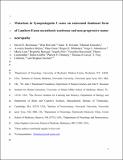Synaptotagmin 2 Mutations Cause an Autosomal-Dominant Form of Lambert-Eaton Myasthenic Syndrome and Nonprogressive Motor Neuropathy
Author(s)
Herrmann, David N.; Horvath, Rita; Sowden, Janet E.; Gonzales, Michael; Sanchez-Mejias, Avencia; Whittaker, Roger G.; Almodovar, Jorge L.; Lane, Maria; Bansagi, Boglarka; Pyle, Angela; Boczonadi, Veronika; Lochmüller, Hanns; Griffin, Helen; Chinnery, Patrick F.; Lloyd, Thomas E.; Zuchner, Stephan; Guan, Zhuo; Littleton, J. Troy; ... Show more Show less
Downloadlittleton troy.pdf (14.20Mb)
PUBLISHER_CC
Publisher with Creative Commons License
Creative Commons Attribution
Terms of use
Metadata
Show full item recordAbstract
Synaptotagmin 2 is a synaptic vesicle protein that functions as a calcium sensor for neurotransmission but has not been previously associated with human disease. Via whole-exome sequencing, we identified heterozygous missense mutations in the C2B calcium-binding domain of the gene encoding Synaptotagmin 2 in two multigenerational families presenting with peripheral motor neuron syndromes. An essential calcium-binding aspartate residue, Asp307Ala, was disrupted by a c.920A>C change in one family that presented with an autosomal-dominant presynaptic neuromuscular junction disorder resembling Lambert-Eaton myasthenic syndrome. A c.923C>T variant affecting an adjacent residue (p.Pro308Leu) produced a presynaptic neuromuscular junction defect and a dominant hereditary motor neuropathy in a second family. Characterization of the mutation homologous to the human c.920A>C variant in Drosophila Synaptotagmin revealed a dominant disruption of synaptic vesicle exocytosis using this transgenic model. These findings indicate that Synaptotagmin 2 regulates neurotransmitter release at human peripheral motor nerve terminals. In addition, mutations in the Synaptotagmin 2 C2B domain represent an important cause of presynaptic congenital myasthenic syndromes and link them with hereditary motor axonopathies.
Date issued
2014-09Department
Massachusetts Institute of Technology. Department of Biology; Massachusetts Institute of Technology. Department of Brain and Cognitive Sciences; Picower Institute for Learning and MemoryJournal
American Journal of Human Genetics
Publisher
Elsevier B.V.
Citation
Herrmann, David N., Rita Horvath, Janet E. Sowden, Michael Gonzales, Avencia Sanchez-Mejias, Zhuo Guan, Roger G. Whittaker, et al. “Synaptotagmin 2 Mutations Cause an Autosomal-Dominant Form of Lambert-Eaton Myasthenic Syndrome and Nonprogressive Motor Neuropathy.” American Journal of Human Genetics 95, no. 3 (September 2014): 332–339.
Version: Author's final manuscript
ISSN
00029297